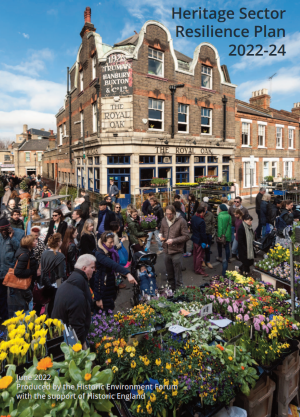 The Heritage Sector Resilience Plan, developed by the Historic Environment Forum (HEF) with the support of Historic England, has been launched.
The Heritage Sector Resilience Plan, developed by the Historic Environment Forum (HEF) with the support of Historic England, has been launched.
… Heritage does not exist in isolation – it is part and parcel of our local communities, our economies…
The Plan states:
…The Heritage Sector Resilience Plan is designed to provide a clear roadmap to a robust and resilient heritage sector. This can only be achieved through a collaborative approach in which everyone with an interest plays their part. The Historic Environment Forum can operate as a facilitator, but the success of the Plan will only be achieved if the whole sector engages with it and contributes to the delivery of the agreed priority actions…
… For each of the themes below, HEF will play a facilitating role…
Review
The plan will be reviewed annually, with reports provided to HEF and published online. Progress against actions identified in the plan will be reviewed at regular HEF meetings throughout the year.
The DCMS will be kept updated regarding progress against the plan, and any changes in priorities.
[The five themes are]:
1 Skills
Our sector is built on the strength of our people – but without enough skilled experts, and the related demand for their expertise, we cannot ensure a resilient heritage ecosystem and secure the huge benefits it brings….
2 Strong governance, business models and capacity
The basics of good internal governance, flexible and adaptable business plans, and strong, collaborative external networks are of central importance to ensuring ongoing resilience across heritage sector organisations, particularly as we have many SMEs and third sector organisations. Whilst these principles and features of good practice cut across all types of organisation, a focus on these skills, competencies and capacities will ensure that we are best equipped to reach our heritage goals….
3 Climate change
Climate change is one of the most challenging issues of our time, with potentially hugely negative consequences for our people and our heritage that directly impact our resilience. Our heritage is directly threatened by the changing climate – from floods to extremes of heat – but it is also affected by people’s responses to climate change, often through unintended negative consequences of actions intended to reduce carbon emissions or improve resilience of our built heritage….
4 Diversity and Inclusion
Our heritage connects us to the past, helps to shape our identity and our understanding of who we are today. A resilient heritage sector is inclusive of and accessible to everyone in the local community. While there is considerable uncertainty about what our future holds, the fact that we are moving towards a more socially, politically and economically diverse future is certain. For our heritage sector to retain its relevance and therefore ensure resilience, it is vital that our heritage reflects an increasingly diverse society…
5 Embedding heritage in wider public policy
Heritage does not exist in isolation – it is part and parcel of our local communities, our economies. It is part of our daily lives and it impacts us as individuals every day. It is vast, and for our heritage to be truly resilient it must be recognised and supported as such. Our local and national policies on the environment, land use, climate change, wellbeing, and levelling up to name a few, all impact heritage, and heritage has a role to play in furthering these policy aims. As such, consideration of and investment in heritage should be at the heart of many national priorities and policies…

